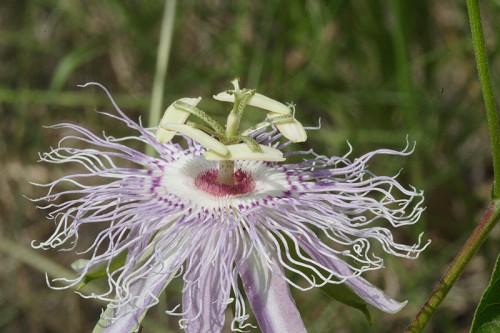Difference between revisions of "Passiflora incarnata"
| Line 34: | Line 34: | ||
''P. incarnata'' proliferates in roadsides, fencerows, thickets, and fields. <ref name= "Weakley 2015"> Weakley, A. S. (2015). Flora of the Southern and Mid-Atlantic States. Chapel Hill, NC, University of North Carolina Herbarium. </ref> | ''P. incarnata'' proliferates in roadsides, fencerows, thickets, and fields. <ref name= "Weakley 2015"> Weakley, A. S. (2015). Flora of the Southern and Mid-Atlantic States. Chapel Hill, NC, University of North Carolina Herbarium. </ref> | ||
===Phenology=== <!--Timing off flowering, fruiting, seed dispersal, and environmental triggers. Cite PanFlora website if appropriate: http://www.gilnelson.com/PanFlora/ --> | ===Phenology=== <!--Timing off flowering, fruiting, seed dispersal, and environmental triggers. Cite PanFlora website if appropriate: http://www.gilnelson.com/PanFlora/ --> | ||
| − | ''P. incarnata'' flowers April-August and October. <ref name= "PanFlora"> PanFlora Author: Gil Nelson URL: [http://www.gilnelson.com/PanFlora/ http://www.gilnelson.com/PanFlora/] Date Accessed: 5/24/18 </ref> | + | ''P. incarnata'' flowers April-August and October. <ref name= "PanFlora"> PanFlora Author: Gil Nelson URL: [http://www.gilnelson.com/PanFlora/ http://www.gilnelson.com/PanFlora/] Date Accessed: 5/24/18 </ref> This plant is a smooth vine with finely hairy stems climbing to a height of 10 to 30 feet. Its smooth or somewhat hairy leaves, 3 to 5 inches broad, consist of three oval or egg-shaped lobes with finely toothed margins. The flowers, which appear from May to July, are solitary and are characterized by a lavender and purple or pink and purple fringe 1 1/2 to 2 inches broad. The plant produces smooth, yellow, many-seeded, edible fruit almost 2 inches long, called maypops. <ref name= "Sievers 1930"> Sievers, A. F. (1930). American medicinal plants of commercial importance. Washington, USDA. </ref> |
<!--===Seed dispersal===--> | <!--===Seed dispersal===--> | ||
<!--===Seed bank and germination===--> | <!--===Seed bank and germination===--> | ||
Revision as of 14:51, 18 June 2018
Common name: purple passionflower [1], maypop [2]
| Passiflora incarnata | |
|---|---|

| |
| Photo by John Gwaltney hosted at Southeastern Flora.com | |
| Scientific classification | |
| Kingdom: | Plantae |
| Division: | Magnoliophyta - Flowering plants |
| Class: | Magnoliopsida - Dicots |
| Order: | Violales |
| Family: | Passifloraceae |
| Genus: | Passiflora |
| Species: | P. incarnata |
| Binomial name | |
| Passiflora incarnata L. | |

| |
| Natural range of Passiflora incarnata from USDA NRCS Plants Database. | |
Contents
Taxonomic Notes
Synonyms: none
Varieties: none
Description
P. incarnata is a perennial forb/herb/vine of the Passifloraceae family native to North America. [1]
Distribution
P. incarnata is found in the southeastern corner of the United States. [1]
Ecology
Habitat
P. incarnata proliferates in roadsides, fencerows, thickets, and fields. [2]
Phenology
P. incarnata flowers April-August and October. [3] This plant is a smooth vine with finely hairy stems climbing to a height of 10 to 30 feet. Its smooth or somewhat hairy leaves, 3 to 5 inches broad, consist of three oval or egg-shaped lobes with finely toothed margins. The flowers, which appear from May to July, are solitary and are characterized by a lavender and purple or pink and purple fringe 1 1/2 to 2 inches broad. The plant produces smooth, yellow, many-seeded, edible fruit almost 2 inches long, called maypops. [4]
Conservation and Management
P. incarnata is listed as rare by the Indiana Department of Natural Resources Division of Nature Preserves, as threatened by the Ohio Department of Natural Resources Division of Natural Areas and Preserves, and as a weedy or invasive species by the University Press of Kentucky and the Southern Weed Science Society. [1]
Cultivation and restoration
Photo Gallery
References and notes
- ↑ 1.0 1.1 1.2 1.3 USDA Plant Database https://plants.usda.gov/core/profile?symbol=PAIN6
- ↑ 2.0 2.1 Weakley, A. S. (2015). Flora of the Southern and Mid-Atlantic States. Chapel Hill, NC, University of North Carolina Herbarium.
- ↑ PanFlora Author: Gil Nelson URL: http://www.gilnelson.com/PanFlora/ Date Accessed: 5/24/18
- ↑ Sievers, A. F. (1930). American medicinal plants of commercial importance. Washington, USDA.